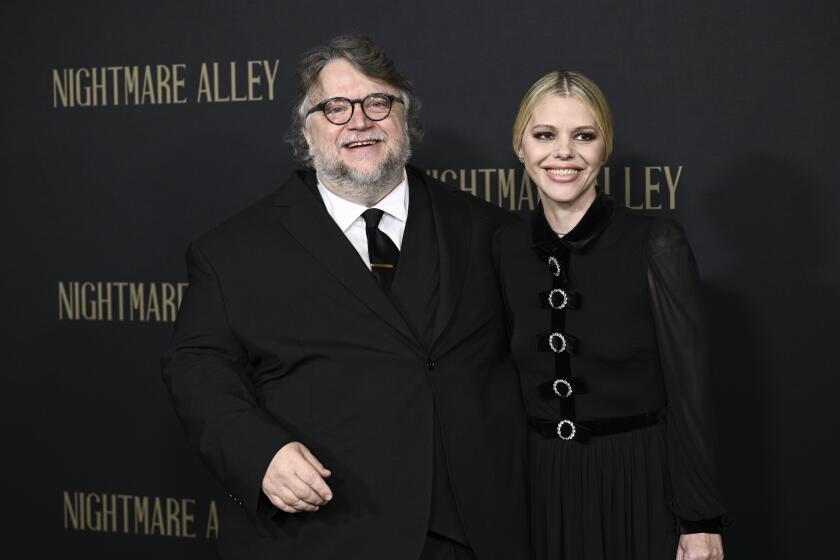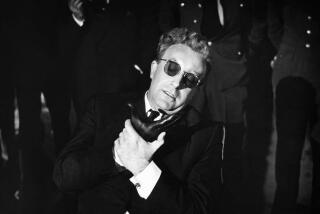How a single word changed Guillermo del Toro’s ‘Nightmare Alley’ ending
- Share via
Spoiler alert: The following story discusses the ending of Guillermo del Toro’s “Nightmare Alley” as well as the original book and film that inspired it. It’s meant to be read once you’ve seen the new film. For less spoiler-y content check out our review and interview with del Toro and co-writer Kim Morgan.
Before Guillermo del Toro’s new “Nightmare Alley” starring Bradley Cooper there was a 1947 movie of the same name directed by Edmund Goulding starring Tyrone Power. Both films were adapted from the 1946 novel by William Lindsay Gresham.
Fans of the earlier works will notice that the ending of the new film picks and chooses between the endings of both the original book and film while making a significant change of its own.
Del Toro’s version tells the story of Stanton Carlisle (Cooper), a drifter with a dark past who signs on with a traveling carnival only to eventually reinvent himself as a supper-club mentalist performing for upscale crowds. When he begins to give personal readings to wealthy customers with the help of a shady psychoanalyst (Cate Blanchett) he thinks he finally has it made. But his eventual downfall puts him right back where he started, hoping for a job at a carnival.
To follow up his Oscar win, Guillermo del Toro and partner Kim Morgan dove into a fresh version of noir classic ‘Nightmare Alley.’
Throughout the film the lowest carnival job is that of “the geek,” a sideshow attraction as man or beast who bites the heads of chickens for terrified crowds. At one point, a carnival manager Clem (Willem Dafoe) explains to Carlisle how he convinces down-and-out alcoholics into working as a geek, telling them its only temporary before ensnaring them in the demeaning job.
Gresham’s book ends with Carlisle being offered a job as a geek, falling prey to a hustle he is well aware of yet unable to fend off. The 1947 film, from a screenplay by Jules Furthman, adds a line of dialogue, with Carlisle saying, “Mister, I was made for it.” The original film also added a brief scene after the final scene from the book, in which Carlisle’s estranged girlfriend Molly (played by Coleen Gray in the original film and Rooney Mara in Del Toro’s version) saves him from this wretched fate.
Del Toro and his co-writer Kim Morgan — a film critic, historian and, as of earlier this year, Del Toro’s wife — decided to drop the scene of Carlisle being saved, as it was supposedly added at the studio’s insistence to finish the bleak movie on a slightly more hopeful note. But they did choose to keep the added line.
“We said, ‘That’s the ending,’ the ending is the revelation of who he really was or the way he really saw himself,” said Del Toro in a recent interview sitting alongside Morgan.
“Which is very sad,” said Morgan. “Sad and freeing.”
“You can look at it as liberating for some, doomed for others,” said Del Toro. “For us, it was a man that wore so many masks for so long that the reward at the end is he gets a mirror and he takes off the mask. We made everything else a prologue to that ending. And I showed it in a way that it could be circular, that he could be crying at the end and start remembering the beginning. You could watch it in a circle.”
Morgan and Del Toro changed Carlisle’s last line from “Mister, I was made for it” to “Mister, I was born for it.” For them that small change held a big significance.
“That one word makes a big difference there because we wanted the audience to know very clearly from the beginning that he was going to end up being the geek,” said Del Toro. “We didn’t want that to be a surprise ... what we wanted is not the what, but the how.”
More to Read
Only good movies
Get the Indie Focus newsletter, Mark Olsen's weekly guide to the world of cinema.
You may occasionally receive promotional content from the Los Angeles Times.










